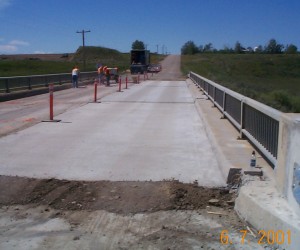Because of our work with Counties, we have many remote sites. Such is the nature of the business, but since concrete begins to cure the moment it gets mixed we often run into problems with the prescribed time limits for concrete travel distance.
What is the limit, and what are the options for dealing with long travel and placement times?
First, I’ll mention the specifications.
The Specifications
- ASTM C94, clause 12.7: Discharge of the concrete shall be completed within 11⁄2 hr after the introduction of the mixing water to the cement and aggregates or the introduction of the cement to the aggregates. This limitation may be waived by the purchaser if the concrete is of such slump or slump flow after the 11⁄2 hr time has been reached that it can be placed, without the addition of water to the batch. In hot weather, or under conditions contributing to rapid stiffening of the concrete, a time less than 11⁄2 hr is permitted to be specified by the purchaser.
- CSA A23.1, clause 5.2.4.3.1: A maximum time limit of 120 min from the time of initial mixing to complete discharge shall be observed. Exemptions to the maximum time limit, if required, shall be agreed upon by the owner and the concrete supplier prior to placement of the concrete. In some circumstances, set retarders may be used to extend the discharge time as permitted by the owner.
- AASHTO M157 is identical to ASTM C94.
Clearly if the specifications are any indication, the point at which concrete loses its workability is around 1.5 to 2 hours after mixing.
The Concerns
The only true concern with long concrete placement times is workability. The concrete is curing right from initial mixing, therefore a long wait time, and hence low slump during placement, will make it difficult to fill the forms adequately and avoid segregation.
The Analysis
The American Society of Concrete Contractors says that the 1 1/2 hr time limit is too conservative, and I tend to agree. One reason is that water reducing admixtures can easily extend the workability of concrete much longer than this. Superplasticizers are present in almost every concrete mix nowadays and they also give another boost.
Another reason is that low workability concrete is normally rejected by the receiving contractor anyway. Because the concrete supplier and placement contractor are not the same company (that I’ve ever seen) the contractor normally rejects the concrete that is out of spec. They don’t enjoy working with low slump concrete anyway, and it is the supplier’s responsibility to provide concrete to the project specification. In that sense, the system is not broken so why try to fix it?
The Alternatives
There are several options during the design phase when dealing with long distances from a concrete plant:
- Don’t use concrete. Is steel an option?
- Use precast. Precast concrete is often poured with no slump (or almost no slump) concrete, because the forms can be vibrated with machinery to allow almost perfect consolidation. It should be on the radar screen regardless.
- Specify an admixture, particularly water reducing admixtures which give the concrete the same slump with less water content. Also, set retarding admixtures prolong the setting time of the concrete.
We’ve had several sites that are greater than 2 hours distance from concrete plants. As such, we will try to avoid cast-in-place concrete at those locations. In most cases precast is an option, but in several cases we still figured that cast-in-place was the best solution. In those cases, we’ve actually found that the concrete arrived in good condition and placement and consolidation was not difficult.
That being said, contractors always have the urge to add water to the concrete to make it more workable. This should be avoided because it affects the structural properties of the concrete, but when the concrete truck has travelled a long distance this is likely to be a concern for the site inspector.
What is your experience with long concrete travel times? Please leave a note in the comments.

Speak Your Mind